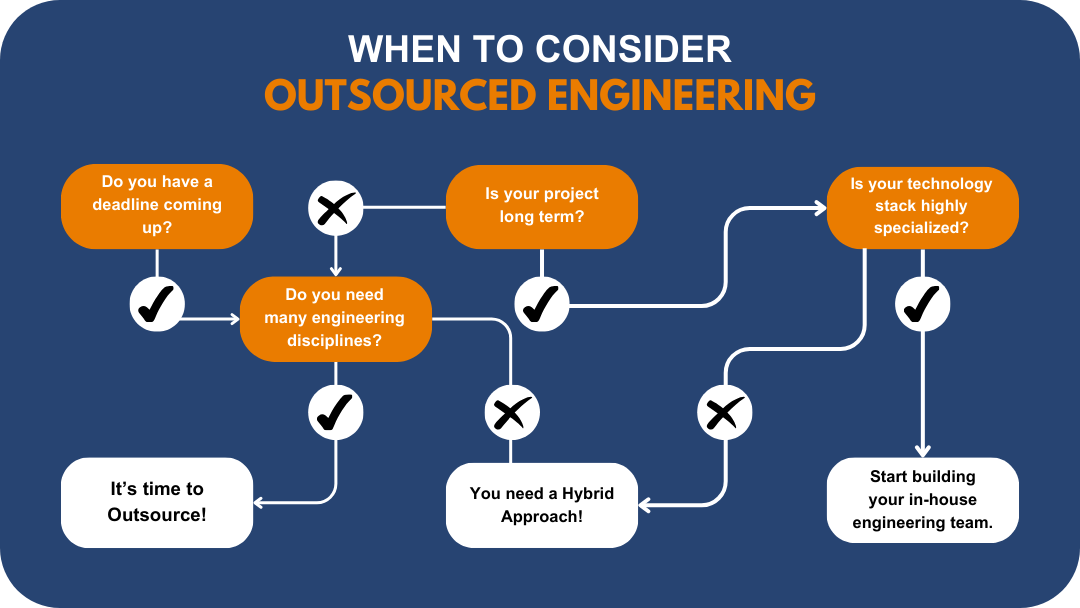Deciding Between Outsourced Engineering Services vs. Hiring Internal Engineering Talent
Are you currently stuck trying to decide if you should outsource your engineering services or start building up an internal team? You may be thinking about the costs, the time, the vetting, and the planning required for both options and be feeling stuck.
At Root3 Labs, we understand that outsourced engineering services can seem costly upfront, while building an in-house team may demand significant time and resources. The right choice depends on your project’s specific needs and long-term goals.
In this guide, we’ll break down the key factors to help you make an informed decision between outsourced engineering and hiring internally, so you can choose the path that leads to success for your business.
Is Outsourced Engineering Right for Your Project? Key Considerations
Pros:
1. Flexibility for Short-Term Projects
- Ideal for finite projects, such as designing a single product for production.
- Allows for easy on-boarding and off-boarding of resources as needed
2. Diverse Expertise On-Demand
- Get access to a range of experienced engineers in various disciplines
- Useful for projects requiring intermittent support from different specialties
3. Reduced Infrastructure Costs
- No need to invest in office space, high-performance computers, or specialized tools
- Eliminates costs associated with employee benefits like healthcare and retirement plans
Cons:
1. Potentially Higher Short-Term Costs
- Billable rates for R&D firms may feel more daunting than an employee’s hourly rate at first glance
2. Less Control Over Resources
- An external engineering team may not work on your project full-time
- May require more coordination and communication efforts
Why Build an In-House Engineering Team? Benefits and Challenges
Pros:
1. Long-Term Resource Availability
- Ideal for ongoing projects or continuous R&D efforts
- Develops institutional knowledge about core technologies
2. Potential Cost-Effectiveness for Consistent Workloads
- More economical for long-term, full-time engineering needs
- Can be cheaper than outsourcing if you need constant support across multiple disciplines
3. Greater Control and Integration
- An in-house team can be more closely aligned with company culture and goals
- Easier to manage and direct resources on a day-to-day basis
Cons:
1. Higher Initial Investment
- Costs associated with hiring, training, and providing benefits
- Need to invest in infrastructure (office space, equipment, software licenses, etc..)
2. Limited Flexibility
- It could be a struggle to fully utilize specialized engineers during project lulls
- Potential difficulty in scaling team size based on project demands
3. Time-Consuming to Build
- Requires significant time to recruit, hire, and onboard a full team
- May delay project timelines while building the team or ramping up new members
When Should You Consider Outsourced Engineering Services?

The Hybrid Approach: In-House Team + Outsourced Support
Like many things in life, often times the best approach is to strike a balance. A great hybrid approach could be hiring some full-time engineers for ongoing, core capabilities, while selectively outsourcing specialized or short-term engineering projects. This hybrid model can provide the stability of in-house expertise with the flexibility and rapid access to diverse skills that outsourcing can offer.
The Bottom Line
Deciding between outsourced engineering needs or building an in-house team is not a simple choice. The pros and cons to both approaches need to be carefully weighed based on your specific project requirements and long-term goals.
The right decision for you and your business will depend on factors like the duration of your engineering needs, the uniqueness of your technology stack, your access to experienced talent, and the overall cost considerations.
Written By: Chad Schneider, MSE, P.E.
Still have questions?
Need help deciding between outsourcing your engineering services or building an in-house team? Our experienced R&D firm can help you evaluate your options and create an engineering strategy tailored to your project needs.




